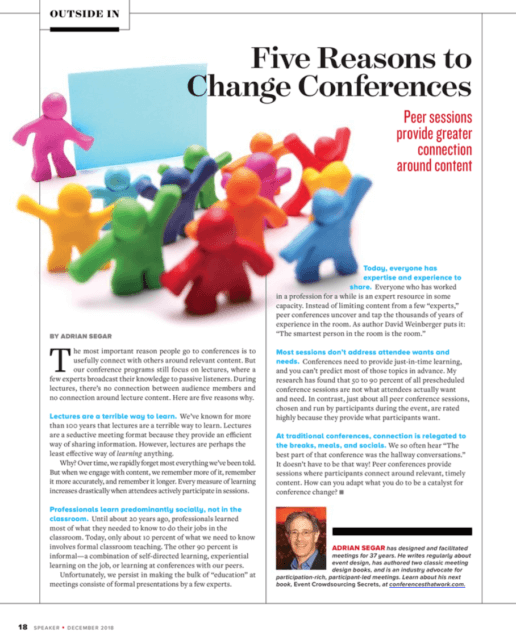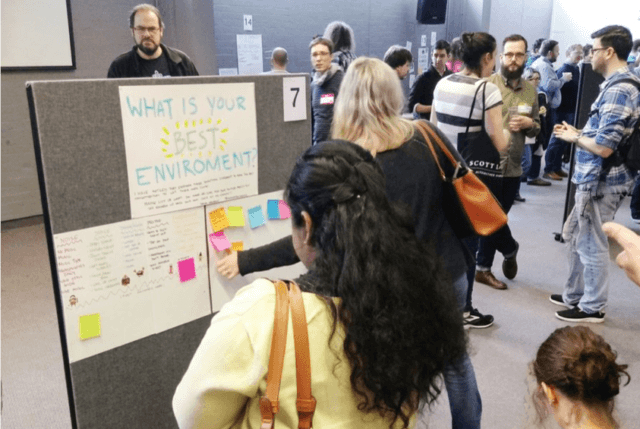Five Reasons to Change Conferences
Here’s my article “Five Reasons to Change Conferences“, published in the December 2018, NSA Speaker magazine.
OUTSIDE IN
Five Reasons to Change Conferences
Peer sessions provide greater connection around content
The most important reason people go to conferences is to usefully connect with others around relevant content. But our conference programs still focus on lectures, where a few experts broadcast their knowledge to passive listeners. During lectures there’s no connection between audience members and no connection around lecture content. Here are five reasons why.
Lectures are a terrible way to learn. We’ve known for over a hundred years that lectures are a terrible way to learn. Lectures are a seductive meeting format because they provide an efficient way of sharing information. However, lectures are perhaps the least effective way of learning anything.
Why? Over time, we rapidly forget almost everything we’ve been told. But when we engage with content, we remember more of it, remember it more accurately, and remember it longer. Every measure of learning increases drastically when attendees actively participate in sessions.
Professionals learn predominantly socially, not in the classroom. Until about twenty years ago, professionals learned most of what they needed to know to do their jobs in the classroom. Today only about 10% of what we need to know involves formal classroom teaching. The other 90% is informal — a combination of self-directed learning, experiential learning on the job or learning at conferences with our peers.
Unfortunately, we persist in making the bulk of “education” at meetings consist of formal presentations by a few experts.
Today, everyone has expertise and experience to share. Everyone who has worked in a profession for a while is an expert resource in some capacity. Instead of limiting content to a few “experts,” peer conferences uncover and tap the thousands of years of expertise and experience in the room. As author David Weinberger puts it: “The smartest person in the room is the room.”
Most sessions don’t address actual attendee wants and needs. Conferences need to provide just-in-time learning, and you can’t predict most of those topics in advance. My research has found that 50 – 90% of all prescheduled conference sessions are not what attendees actually want and need. In contrast, just about all peer conference sessions, chosen and run by participants during the event, are rated highly because they provide what participants want.
At traditional conferences, connection is relegated to the breaks, meals, and socials. We so often hear “The best part of that conference was the hallway conversations.” It doesn’t have to be that way! Peer conferences provide conference sessions where participants connect around relevant, timely content. How can you adapt what you do to be a catalyst for conference change?
Adrian Segar has designed and facilitated meetings for 37 years. He writes regularly about event design, has authored two classic meeting design books, and is an industry advocate for participation-rich, participant-led meetings. Learn about his next book: The Little Book of Event Crowdsourcing Secrets.


 During my 20+ years as an IT consultant and developer, I fell in with a delightful international crowd of software testers: those all-important people responsible for the impossible task of making sure that software works the way it’s supposed to. (Fun fact: the testing community often uses my term “peer conferences” for their get-togethers, due to a chat about meeting design I had with tester
During my 20+ years as an IT consultant and developer, I fell in with a delightful international crowd of software testers: those all-important people responsible for the impossible task of making sure that software works the way it’s supposed to. (Fun fact: the testing community often uses my term “peer conferences” for their get-togethers, due to a chat about meeting design I had with tester